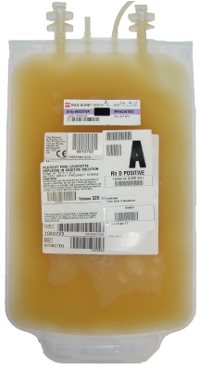Presentation
- Adult platelets are provided either as 1 adult therapeutic dose, resuspended in platelet additive solution (70% electrolyte solution, 30% plasma).
- Single donor apheresis: 180-400mL in 1 bag
- Random donor pooled: 200-350mL in 1 bag
- Paediatric doses are prepared from single donor apheresis platelets (each donation divided into 4 doses) suspended in 100% plasma
- From early 2021, neonatal platelets will be resuspended in platelet additive solution (70% electrolyte solution, 30% plasma).
- Paediatric dose: 45-100mL (usually 50mL) in 1 bag
- Occasionally HLA matched single donor apheresis platelets are prepared for specific recipients

ABO & RhD Compatibility
ABO
- The Blood Bank will normally provide Platelet Concentrates that are ABO identical to the recipient or are ABO compatible (see table for Red Cells) but it is not a strict requirement for platelet concentrates to be ABO compatible.
Rh(D) (the "positive or "negative" part of the blood group)
- If possible, platelet concentrations from Rh(D) negative donors will be provided for Rh(D) negative recipients
- Where a platelet concentrate from an Rh(D) positive donor is given to an Rh(D) negative recipient the use of Anti-D prophylaxis must be considered due to the presence of trace quantities of red cells in platelet concentrates. This guideline applies to all Rh(D) negative females of childbearing age and to female children. Seek advice from the Transfusion Medicine Specialist.
Storage
- This product is stored at 20-24°C (room temperature) with constant agitation (usually in Blood Bank).
- Transfuse as soon as possible. Return to Blood Bank if not immediately used.
- Never store in a refrigerator
- Platelets expire seven days from donation. This has been extended from five to seven days with the implementation of 100% bacterial testing. Please see page 4 of the October Blood Issues for more information about the change to seven day shelf life.
Filter
- Use a standard blood infusion set that has a 170-200 micron filter.
- One administration set may be used for administration of 2-4 units of red blood cells provided the flow rate remains adequate. In a massive transfusion situation, 8-10 units may be transfused before the set is changed, providing that the set is changed every 8 hours. Platelets should only be administered through a new blood giving set.
- All fresh components, including FFP and cryoprecipitate, are leucodepleted at source by NZBS. No bedside leucodepletion is necessary.
Pump
- Approved infusion pump devices may be used.
Rate and Duration
- Paediatrics:
- in a non-bleeding patient: Infuse at 10-20mL/kg/hour using a new blood infusion set.
- resuscitation: rapid infusion based on the patient's haemodynamics
- Adults:
- in a non-bleeding patient: Infuse within one hour using a new blood infusion set
- resuscitation: rapid infusion based on the patient's haemodynamics
- Infusion of all components should be completed within one hour of leaving controlled storage.
Monitoring
- See page on Observations
DO NOT
- DO NOT add medication to platelet concentrates
- DO NOT use 5% Dextrose solutions (may induce haemolysis)
- DO NOT use Lactated Ringer's or other balanced salt solutions that contain Calcium, as this may induce clot formation in the blood bag and / or administration set.
Dose
- Each adult (300mL) bag of platelets is a standard therapeutic dose of platelets. We no longer make "six packs".
- For neonates and paediatric patients: give 10mL/kg, to a maximum of one adult unit.
- For paediatric patients, the dose should be written in mL, not units.
Platelet Refractoriness
- coagulopathy
- sepsis
- hypersplenism
- drugs
- antibody-mediated consumption
More Info
- Patient Information Leaflet
- Datasheets
- Corrected Count Increment (CCI) calculator
- Article describing NZBS's platelet additive solution (SSP+)
- Platelet refractoriness investigation request form
- British Society for Haematology (BSH) guideline for platelet transfusions (2016)
- ANZSBT Guidelines on how to administer blood products
- NZBS policy on the provision of CMV antibody negative blood components
- Guidelines for the Management of Patients Refractory to Platelets
- Blood Component Support of Rh(D) Negative Individuals
- Transfusion Medicine Handbook
- NZBS Clinical Compendium
- Patient Blood Management guidelines